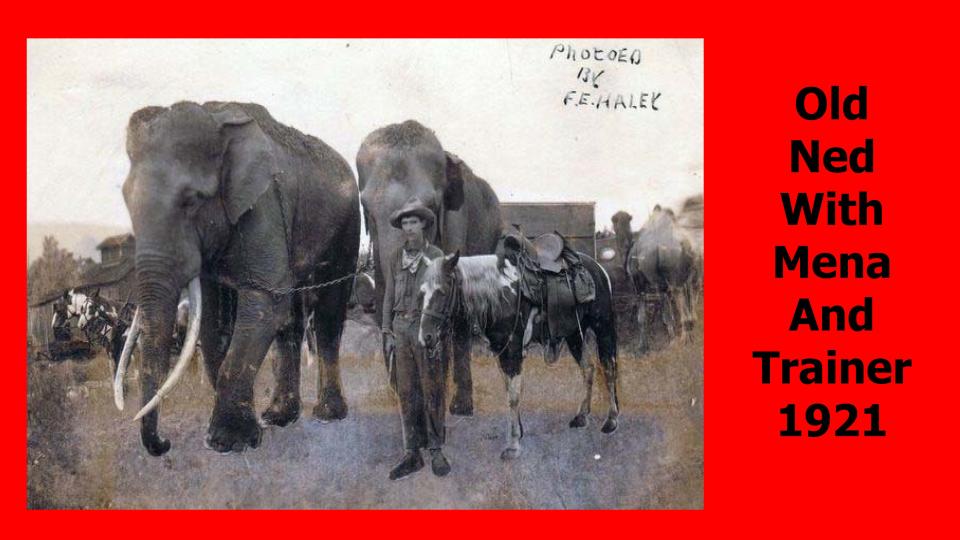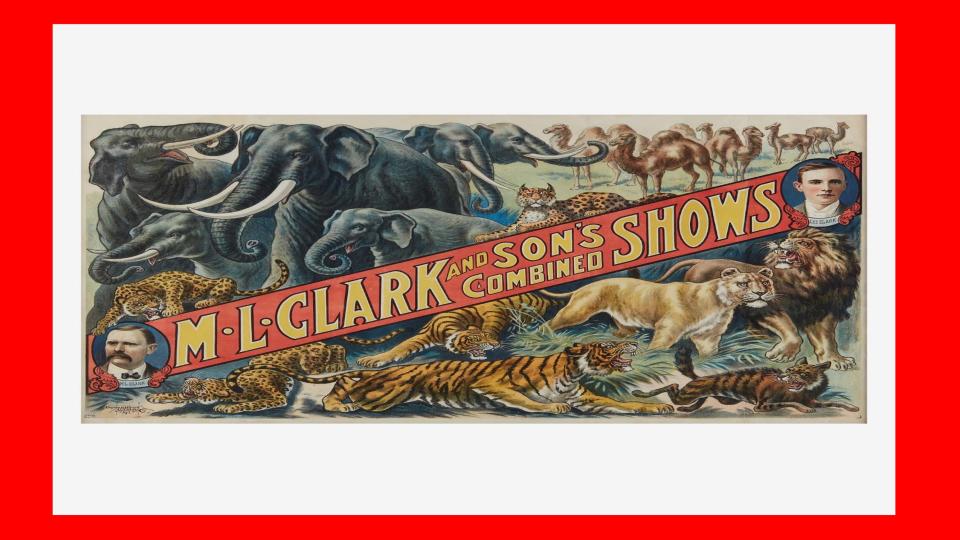Under the big top: Alexandria was once home to 'Largest Little Circus in America'
Step right up, Ladies and Gentlemen, and listen to local historian Mike Wynne tell a tale of tales about a colorful but forgotten part of Alexandria's history. It was once the winter headquarters of the former M.L. Clark and Son's Circus from the 1890s to the 1930s. You might even hear that somewhere in town, there is an elephant graveyard and another where many of the other circus animals were buried.
"Wiley Clark, in 1885, had a traveling medicine show that developed into a minstrel show that developed into a circus," said Wynne. "He teamed up with his younger brother M.L. (Mack Loren) Clark and by 1890 they had what they called the 'Largest Little Circus in America.'"
The brothers needed a winter headquarters for the circus and chose Alexandria.
"From the early 1890s to the 1930s, Alexandria was well known around the nation as being the home of the M.L. Clark Circus," he said.
At the circus' peak in 1908, it had 12 cages of large animals, 60 wagons, 200 horses and just as many mules.
"They had six elephants and two giant tents. It was a big operation," Wynne told Rotary Club of Alexandria members at a weekly luncheon.
The circus traveled as far west as Utah, Canada and New England, said Wynne. They were a "mud show" in their early days meaning they traveled in wagons on dirt roads and the wagons would get muddy.

Where circus was located
In the 1890s, Wynne said, M.L. bought land centering on Monroe Street past Chester Street in Alexandria. It extended from Rapides Avenue to Avenues A, B and C to Elliott Street.
"Back then, there was no Monroe Street past where it now intersects with Chester," said Wynne. "This was a forest that had been cut and it was just overgrown fields. And the circus had these 995 acres centering basically on Monroe Street."
M.L. purchased the land for $1,200 in 1892, said Wynne. And the Clark family and circus performers lived in barns on the property.
Also kept on the property were numerous animals that included horses, hyenas, wild cats, wild boars, kangaroos, bears, tropical birds, performing ponies, lions, camels, monkeys and yes - even elephants.
A railroad line through the area and a station, Union Station, was built just for the circus to load and unload animals after it became a railroad show in 1920, said Wynne.
In 1907, M.L.'s wife, bought a pre-fab house from the Sears Roebuck catalog.
"It was the first year that they ever sold ready-made or pre-fab houses," said Wynne.
The house was shipped from Chicago by train and put together with wooden pins and no nails. The five-room house took less than two days to assemble.
The house, which is no longer standing, was located off Monroe Street in the area that Harmony Village now occupies.
The Clark family sold the property in 1940 to the U.S. Government which built the Sunset housing project for soldiers returning from World War II and their families. The house was torn down during that time.
The animal and elephant graveyards
There is also an animal graveyard in Alexandria where many of the bones animals connected to the circus are buried, said Wynne. It is located off Monroe Street.
"Not only did animals die over the years but animals were fed to other animals - lions, tigers, bears," said Wynne.
"M.L. Clark's son (Lee) did a lengthy interview with The Town Talk in 1965 and he described where the animal graveyard was and showed a picture in The Town Talk," said Wynne. "So I took this picture and went down Monroe Street and I found it."
Back in 1965, the area was an empty lot but a house was built on it and for that reason, Wynne won't tell people exactly where it is.
"But," he teased. "It may be in my book."
And, there is a graveyard where an elephant was killed and buried.
"I've been hearing for years about the one elephant that was buried near Avenue C," said Wynne.
A 1952 article that appeared in The Town Talk states that a woman was digging in her yard and found what she thought were dinosaur bones, said Wynne. After the bones were examined, it was determined that they were elephant bones.
"She was so disappointed," Wynne added.

Old Ned and Mena the Elephants
Old Ned and his girlfriend Mena were two of the elephants that were part of the M.L. Clark Circus but neither is the one that was killed and buried there.
Wynne said that Old Ned was at one time the largest performing elephant in the world and he lived on Monroe Street.
Later on, Clark sold Old Ned to the Al G. Barnes Circus and he was renamed Tusko.
"His tusks, when he was fully grown, were as big as large man's legs," said Wynne. "He was just an incredible size."
Mena the Elephant was bought by M.L. Clark along with Mose, a Bactrian camel, that was considered the largest camel in captivity.
In 1943, Mena was retired and living in Oklahoma when word got back to Alexandria that "the old elephant that lived down Monroe Street" was up for sale for $200, said Wynne.
"The children of Alexandria, in 1943, put their pennies and nickels together and collected $200 and she was purchased," he said.
But unfortunately, Mena died en route to Alexandria.
Celebrity connections to the circus
Two notable celebrities of bygone eras were connected to the M.L. Clark Circus.
One, a musician, was born to two circus performers.
"Harry James was famous for his jazz bands in '30s and '40s," said Wynne. "He was a cornet player. But he was born at the M.L. Clark Circus. His father was a musician for the band. His mother was an aerialist for the circus and his maternal grandfather was head of the M.L. Clark Circus Band. Although he didn't officially play with the circus, he traveled with the circus in his youth."
The other, Tom Mix, was a superstar of silent films of the early 20th century.
"He made 221 silent movies," said Wynne. "In 1910, he lived on Monroe Street and was a livestock hustler."
How the circus got started
The story of how the M.L. Clark Circus came to be with Wiley who was 20 years old in the late 1870s and didn't like to work, said Wynne.
"So he turned to conning people," he said. "He had his own patent medicine show."
But the trouble he had with this was getting people to his wagon to do his spiel to sell medicine.
"So he started getting into a little entertainment," said Wynne. "In the early 1880s, he started doing all sorts of other things to do this."
Wiley trained himself to do ventriloquism, magic, puppetry and minstrels.
The first newspaper article Wynne found on Wiley appeared in the Colfax Chronicle. He did a ventriloquism show in Colfax going by the name Professor Clark.
Then Wynne found a Town Talk article from Nov. 2, 1884, that announced Wiley was bringing his show to Alexandria. The show would include a ventriloquist, comedians, a banjoist, an aerial performer, and a comic vocalist.
And, he was bringing "The Great Leo" who was a female impersonator.
"And this was in downtown Alexandria in 1884," said Wynne. "That was your entertainment."
As the show became more popular, Wiley added a balloon ascension and a doctor who traveled with the show who would extract teeth for free.
In 1884, M.L. joined his brother Wiley and formed the Clark Brothers Circus. M.L. had his own wagon so he could pull stuff.
Empress the Elephant
"Their first big act was Empress the Elephant'," said Wynne.
As it turns out, Empress wasn't very cooperative. Then, the brothers found out that Empress had killed the last four people who handled him. So, they quickly sold the elephant to another circus but didn't tell them about Empress' "killing spree," said Wynne.
Then, Empress killed his new owner, said Wynne. And his widow had handlers take Empress into the swamp where he was killed.
"She sold tickets for people to come and watch," said Wynne. "She had her roustabouts kill the elephant and then cut off pieces of the elephant to sell to the spectators."
M.L. Clark died in 1926 and his son Lee sold the circus in 1930. It lasted until 1945.
The story of the M.L. Clark Circus may be forgotten in Alexandria and Rapides Parish history, said Wynne, but an exhibit on the circus is in the Circus World Museum in Baraboo, Wis.
More can be read about the circus in a book Wynne wrote, "Hurry, Hurry, Hurry, Step Right Up To The Greatest Show On Earth!": The True Story of the "Largest Little" Circus in the United States - The M. L. Clark and Son's Circus that can be purchased on Amazon.com
This article originally appeared on Alexandria Town Talk: Alexandria was once home to 'Largest Little Circus in America'

